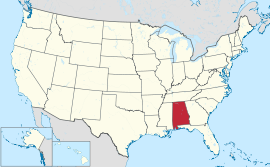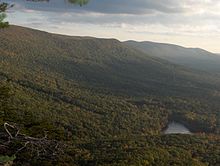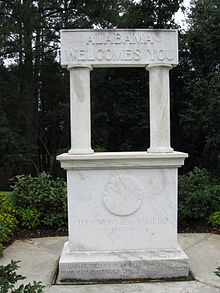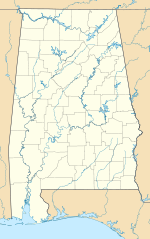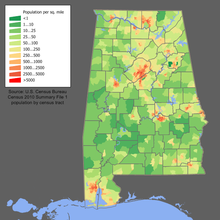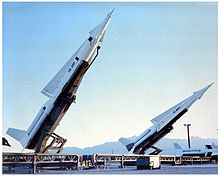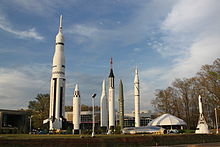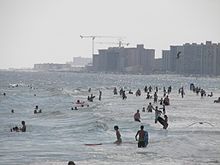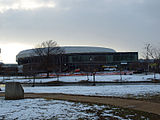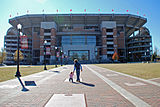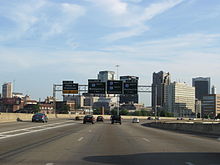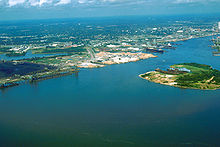- Alabama
-
This article is about the U.S. state of Alabama. For the river, see Alabama River. For other uses, see Alabama (disambiguation).
State of Alabama 

Flag Seal Nickname(s): Yellowhammer State; Heart of Dixie; Cotton State Motto(s): Audemus jura nostra defendere (Latin) Official language(s) English Spoken language(s) English (96.17%)
Spanish (2.12%)Demonym Alabamian Capital Montgomery Largest city Birmingham
212,237 (2010 census)Largest metro area Greater Birmingham Area Area Ranked 30th in the U.S. - Total 52,419 sq mi
(135,765 km2)- Width 190 miles (305 km) - Length 330 miles (531 km) - % water 3.20 - Latitude 30° 11′ N to 35° N - Longitude 84° 53′ W to 88° 28′ W Population Ranked 23rd in the U.S. - Total 4,779,736 (2010)[1]
4,447,100 (2000)- Density 91.18/sq mi (35.2/km2)
Ranked 27th in the U.S.Elevation - Highest point Mount Cheaha[2][3][4]
2,413 ft (735.5 m)- Mean 500 ft (150 m) - Lowest point Gulf of Mexico[3]
sea levelBefore statehood Alabama Territory Admission to Union December 14, 1819 (22nd) Governor Robert J. Bentley (R) Lieutenant Governor Kay Ivey (R) Legislature Alabama Legislature - Upper house Senate - Lower house House of Representatives U.S. Senators Richard Shelby (R)
Jeff Sessions (R)U.S. House delegation 6 Republicans, 1 Democrat (list) Time zone Central: UTC-6/DST-5 Abbreviations AL Ala. US-AL Website alabama.gov Alabama State symbols The Flag of Alabama. Animate insignia Amphibian Red Hills salamander Bird(s) Yellowhammer, Wild Turkey Butterfly Eastern Tiger Swallowtail Fish Largemouth bass, Fighting tarpon Flower(s) Camellia, Oak-leaf Hydrangea Insect Monarch Butterfly Mammal(s) American Black Bear, Racking horse Reptile Alabama red-bellied turtle Tree Longleaf Pine Inanimate insignia Beverage Conecuh Ridge Whiskey Colors Red, White Dance Square Dance Food Pecan, Blackberry, Peach Fossil Basilosaurus Gemstone Star Blue Quartz Mineral Hematite Rock Marble Shell Johnstone's Junonia Slogan(s) Share The Wonder,
Alabama the beautiful,
Where America finds its voice,
Sweet Home AlabamaSoil Bama Song(s) Alabama (song) Route marker(s) 
State Quarter 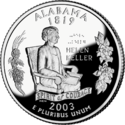
Released in 2003 Lists of United States state insignia Alabama
 i/ˌæləˈbæmə/ is a state located in the southeastern region of the United States. It is bordered by Tennessee to the north, Georgia to the east, Florida and the Gulf of Mexico to the south, and Mississippi to the west. Alabama ranks 30th in total land area and ranks second in the size of its inland waterways. The state ranks 23rd in population with 4.7 million residents in 2009.[5]
i/ˌæləˈbæmə/ is a state located in the southeastern region of the United States. It is bordered by Tennessee to the north, Georgia to the east, Florida and the Gulf of Mexico to the south, and Mississippi to the west. Alabama ranks 30th in total land area and ranks second in the size of its inland waterways. The state ranks 23rd in population with 4.7 million residents in 2009.[5]From the American Civil War until World War II, Alabama, like many Southern states, suffered economic hardship, in part because of continued dependence on agriculture. Despite the growth of major industries and urban centers, white rural interests dominated the state legislature until the 1960s, while urban interests and African Americans were under-represented.[6] Following World War II, Alabama experienced growth as the economy of the state transitioned from agriculture to diversified interests in heavy manufacturing, mineral extraction, education, and technology. In addition, the establishment or expansion of multiple military installations, primarily those of the U.S. Army and U.S. Air Force, added to state jobs.
Alabama is unofficially nicknamed the Yellowhammer State, after the state bird. Alabama is also known as the "Heart of Dixie". The state tree is the Longleaf Pine, the state flower is the Camellia. The capital of Alabama is Montgomery. The largest city by population is Birmingham. The largest city by total land area is Huntsville. The oldest city is Mobile, founded by French colonists.
Contents
History
Main article: History of AlabamaEtymology
The Alabama (people), a Muskogean-speaking tribe whose members lived just below the confluence of the Coosa and Tallapoosa Rivers on the upper reaches of the Alabama River,[7] served as the etymological source of the names of the river and state. In the Alabama language, the word for an Alabama person is Albaamo (or variously Albaama or Albàamo in different dialects; the plural form "Alabama persons" is Albaamaha).[8] The word Alabama is believed to have originated from the Choctaw language[9] and was later adopted by the Alabama tribe as their name.[10] The spelling of the word varies significantly between sources.[10] The first usage appears in three accounts of the Hernando de Soto expedition of 1540 with Garcilasso de la Vega using Alibamo, while the Knight of Elvas and Rodrigo Ranjel wrote Alibamu and Limamu, respectively.[10] As early as 1702, the tribe was known to the French as Alibamon with French maps identifying the river as Rivière des Alibamons.[7] Other spellings of the appellation have included Alibamu, Alabamo, Albama, Alebamon, Alibama, Alibamou, Alabamu, and Allibamou.[10][11][12][13]
Although the origin of Alabama could be discerned, sources disagree on its meaning. An 1842 article in the Jacksonville Republican originated the idea that the meaning was "Here We Rest."[10] This notion was popularized in the 1850s through the writings of Alexander Beaufort Meek.[10] Experts in the Muskogean languages have been unable to find any evidence to support such a translation.[7][10] Scholars believe the word comes from the Choctaw alba (meaning "plants" or "weeds") and amo (meaning "to cut", "to trim", or "to gather").[9][10][14] The meaning may have been "clearers of the thicket"[9] or "herb gatherers"[14][15] which may refer to clearing of land for cultivation[11] or to collecting medicinal plants.[15]
Indigenous peoples, early history
Indigenous peoples of varying cultures lived in the area for thousands of years before European colonization. Trade with the Northeast via the Ohio River began during the Burial Mound Period (1000 BC–AD 700) and continued until European contact.[16] The agrarian Mississippian culture covered most of the state from AD 1000 to 1600, with one of its major centers being at the Moundville Archaeological Site in Moundville, Alabama.[17][18] Analysis of artifacts recovered from archaeological excavations at Moundville were the basis of scholars' formulating the characteristics of the Southeastern Ceremonial Complex (SECC).[19] Contrary to popular belief, the SECC appears to have no direct links to Mesoamerican culture, but developed independently. The Ceremonial Complex represents a major component of the religion of the Mississippian peoples; it is one of the primary means by which their religion is understood.[20]
Among the historical tribes of Native American people living in the area of present-day Alabama at the time of European contact were Iroquoian-speaking Cherokee, and the Muskogean-speaking Alabama (Alibamu), Chickasaw, Choctaw, Creek, Koasati, and Mobile.[21]
European settlement
The French founded the first European settlement in the region at Old Mobile, in 1702.[22] The area was French from 1702 to 1763; part of British West Florida from 1763 to 1780. Thomas Bassett was the first British settler in the state. He settled near what is now Tombigbee River in Washington County.[23] Alabama became part of Spanish West Florida from 1780 to 1810; part of the independent Republic of West Florida for a short time (90 days); annexed by the U.S. and added to the Territory of Orleans (1810); and, finally, added to the Mississippi Territory in 1812. Throughout these later developments, however, the Spanish had kept a nominal (although largely ignored) governmental presence in the region, based out of Mobile. When Andrew Jackson's forces occupied Mobile in 1814 —while preparing for the Battle of New Orleans —he demonstrated the United States' de facto authority over the region, effectively ending Spanish governance (though not its claim), while gaining an unencumbered passage to the gulf.[24]
The area making up today's northern and central Alabama, known as the Yazoo lands, had been claimed by the Province of Georgia after 1763. Following the Revolutionary War, it remained a part of the state of Georgia —although heavily disputed. Conflicting claims to the area were held, first by several Native American tribes (most notably the Chickamauga-Cherokee and Yazoo), by other states (e.g. South Carolina); and by the US federal government; Britain and Spain. In 1802, the region was joined to the Mississippi Territory. Individual statehood was delayed, however, by the territory's lack of a coastline.
Statehood, Civil War and Reconstruction
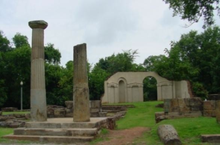 Old Alabama state capital ruins at Capital Park in Tuscaloosa
Old Alabama state capital ruins at Capital Park in Tuscaloosa
Alabama became the twenty-second state —admitted to the Union in 1819. Part of the frontier in the 1820s and 1830s, its constitution provided for universal suffrage for white men. Settlers rapidly arrived to take advantage of the fertile soil. Southeastern planters and traders from the Upper South brought slaves with them as the cotton plantations expanded. The economy of the central "Black Belt" (named for its dark, productive soil) was built around large cotton plantations whose owners' wealth grew largely from slave labor.[25] The area also drew many poor, disfranchised people who became subsistence farmers. The 1860 census records show that enslaved Africans comprised 45% of the state's total population of 964,201. There were only 2,690 free persons of color living in Alabama at the time.
From 1826 to 1846, Tuscaloosa served as the capital of Alabama. On January 30, 1846, the Alabama legislature announced that it had voted to remove the capital city from Tuscaloosa to Montgomery. The first legislative session in the new capital met in December 1847. In time, a Capitol building was erected under the direction of a Philadelphia, Pennsylvania architect. The original structure burnt down in 1849 but was rebuilt in 1851 following the original plans.[26]
On January 11, 1861, Alabama declared its secession from the Union and joined the Confederate States of America. While few battles were fought in the state, Alabama contributed about 120,000 soldiers to the American Civil War. Alabama's slaves were freed by the 13th Amendment in 1865.[27] During Reconstruction, the new state legislators created a public school system for the first time, as well as establishing some welfare institutions to help its people. Alabama was officially restored to the Union in 1868.
After the Civil War, the state was still chiefly agricultural, with an economy tied to cotton. Planters resisted working with free labor during Reconstruction and sought to re-establish controls over freedmen. In the early years the Ku Klux Klan had numerous independent chapters in Alabama that attacked freedmen and other Republicans. After it was suppressed, insurgent whites organized paramilitary groups, such as the Red Shirts and White League, that acted more openly to suppress black voting. Regaining power by the late 1870s, in the last decade of the 19th century, white Democrats passed electoral laws disfranchise most blacks and many poor whites.[28] Having regained power in the state legislature, Democrats passed Jim Crow laws, including racial segregation in public facilities, to restore white supremacy in the society.
In 1875, the state passed the Blaine Amendment, to prohibit public money from being used to finance Catholic schools.[29]
1900–1960
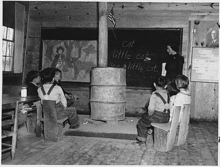 School in Alabama (Farm Security Administration, 1935)
School in Alabama (Farm Security Administration, 1935)
The new 1901 Constitution of Alabama effectively disfranchised African Americans and many poor whites through voting restrictions, including literacy requirements. While the planter class had persuaded poor whites to support these legislative efforts, the new restrictions resulted in disfranchising poor whites as well, due mostly to imposition of a cumulative poll tax.
In 1900, 14 Black Belt counties had more than 79,000 voters on the rolls.[clarification needed] By June 1, 1903, the number of[clarification needed] registered voters had dropped to 1,081. In 1900, Alabama had more than 181,000 African Americans eligible to vote. By 1903, only 2,980 had qualified to register, although at least 74,000 black voters were literate.[30]
By 1941, a total of more whites than blacks had been disfranchised: 600,000 whites to 520,000 blacks.[30] Nearly all African Americans lost the ability to vote.
The disfranchisement was ended by African Americans' leading the Civil Rights Movement and gaining Federal legislation in the mid-1960s to protect their voting and civil rights. The Voting Rights Act of 1965 also protected the suffrage of poor whites.
The rural-dominated Alabama legislature consistently underfunded schools and services for the disfranchised African Americans in the segregated state, but did not relieve them of paying taxes.[25] Continued racial discrimination, agricultural depression, and the failure of the cotton crops due to boll weevil infestation led tens of thousands of African Americans to seek opportunities in northern cities. They left Alabama in the early 20th century as part of the Great Migration to industrial jobs and better futures in northern industrial cities. The population growth rate in Alabama (see "Historical Populations" table below) dropped by nearly half from 1910 to 1920, reflecting the effect of emigration.
At the same time, many rural whites and blacks migrated to the city of Birmingham for work in new industrial jobs. It experienced such rapid growth that it was nicknamed "The Magic City". By the 1920s, Birmingham was the 19th largest city in the U.S. and held more than 30% of the population of the state. Heavy industry and mining were the basis of the economy.[31]
This structure greets drivers visiting the Alabama Welcome Center just inside the AL/GA border off of Interstate 20.
Industrial development related to the demands of World War II brought prosperity.[25] Cotton faded in importance as the state developed a manufacturing and service base. In the 1960s under Governor George Wallace, many whites in the state opposed federal integration efforts in schools and public facilities.
1960–present
Despite massive population changes in the state from 1901 to 1961, the rural-dominated legislature refused to reapportion House and Senate seats based on population. They held on to old representation to maintain political and economic power in agricultural areas. In addition, the state legislature gerrymandered the few Birmingham legislative seats to ensure election by persons living outside Birmingham.
One result was that Jefferson County, containing Birmingham's industrial and economic powerhouse, contributed more than one-third of all tax revenue to the state, but did not receive a proportional amount in services. Urban interests were consistently underrepresented in the legislature. A 1960 study noted that because of rural domination, "A minority of about 25 per cent of the total state population is in majority control of the Alabama legislature."[6]
African Americans were presumed partial to Republicans for historical reasons, but they were disfranchised. White Alabamans felt bitter towards the Republican Party in the aftermath of the Civil War and Reconstruction. These factors created a longstanding tradition that any candidate who wanted to be viable with white voters had to run as a Democrat regardless of political beliefs.
During the Civil Rights Movement, African Americans achieved a protection of voting and other civil rights through the passage of the national Civil Rights Act of 1964,[32] and the Voting Rights Act of 1965. De jure segregation ended in the states as Jim Crow laws were invalidated or repealed.[33]
Under the Voting Rights Act of 1965, cases were filed in Federal courts to force Alabama to properly redistrict by population both the House and Senate of the state legislature. In 1972, for the first time since 1901, the legislature implemented the Alabama constitution's provision for periodic redistricting based on population. This benefited the urban areas that had developed, as well as all in the population who had been underrepresented for more than 60 years.[6]
After 1972, the state's white voters shifted much of their support to Republican candidates in presidential elections (as also occurred in neighboring southern states). Since 1990 the majority of whites in the state have voted increasingly Republican in state elections. In 2010, Republicans won control of both houses of the legislature for the first time in 136 years.[34]
Geography
 Alabama terrain map: shows lakes, rivers, roads, with Mount Cheaha (right center) east of Birmingham.
Alabama terrain map: shows lakes, rivers, roads, with Mount Cheaha (right center) east of Birmingham. Main article: Geography of AlabamaSee also: List of Alabama counties and Geology of Alabama
Main article: Geography of AlabamaSee also: List of Alabama counties and Geology of AlabamaAlabama is the thirtieth-largest state in the United States with 52,423 square miles (135,770 km2) of total area: 3.19% of the area is water, making Alabama twenty-third in the amount of surface water, also giving it the second-largest inland waterway system in the United States.[35] About three-fifths of the land area is a gentle plain with a general descent towards the Mississippi River and the Gulf of Mexico. The North Alabama region is mostly mountainous, with the Tennessee River cutting a large valley creating numerous creeks, streams, rivers, mountains, and lakes.[36]
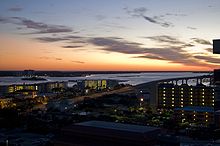 View of Perdido Pass from Orange Beach
View of Perdido Pass from Orange Beach
The states bordering Alabama are Tennessee to the north; Georgia to the east; Florida to the south; and Mississippi to the west. Alabama has coastline at the Gulf of Mexico, in the extreme southern edge of the state.[36] Alabama ranges in elevation from sea level[37] at Mobile Bay to over 1,800 feet (550 m) in the Appalachian Mountains in the northeast. The highest point is Mount Cheaha,[36] at a height of 2,413 ft (735 m).[38] Alabama's land consists of 22 million acres (89,000 km2) of forest or 67% of total land area.[39] Suburban Baldwin County, along the Gulf Coast, is the largest county in the state in both land area and water area.[40]
Areas in Alabama administered by the National Park Service include Horseshoe Bend National Military Park near Alexander City; Little River Canyon National Preserve near Fort Payne; Russell Cave National Monument in Bridgeport; Tuskegee Airmen National Historic Site in Tuskegee; and Tuskegee Institute National Historic Site near Tuskegee.[41] Additionally, Alabama has four National Forests: Conecuh, Talladega, Tuskegee, and William B. Bankhead.[42] Alabama also contains the Natchez Trace Parkway, the Selma To Montgomery National Historic Trail, and the Trail Of Tears National Historic Trail. A notable natural wonder in Alabama is "Natural Bridge" rock, the longest natural bridge east of the Rockies, located just south of Haleyville.
A 5-mile (8 km)-wide meteorite impact crater is located in Elmore County, just north of Montgomery. This is the Wetumpka crater, which is the site of "Alabama's greatest natural disaster".[43] A 1,000-foot (300 m)-wide meteorite hit the area about 80 million years ago.[43] The hills just east of downtown Wetumpka showcase the eroded remains of the impact crater that was blasted into the bedrock, with the area labeled the Wetumpka crater or astrobleme ("star-wound") because of the concentric rings of fractures and zones of shattered rock that can be found beneath the surface.[44] In 2002, Christian Koeberl with the Institute of Geochemistry University of Vienna published evidence and established the site as an internationally recognized impact crater.[43]
Urban areas
 Birmingham, largest city and metropolitan area
Birmingham, largest city and metropolitan area
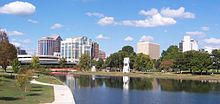 Huntsville, second-largest metropolitan area
Huntsville, second-largest metropolitan area
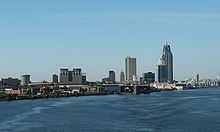 Mobile, third-largest metropolitan area
Mobile, third-largest metropolitan area
 Montgomery, fourth-largest metropolitan area
Montgomery, fourth-largest metropolitan area
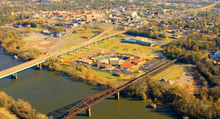 Tuscaloosa, fifth-largest metropolitan area
Tuscaloosa, fifth-largest metropolitan area Main article: List of Metropolitan areas of AlabamaSee also: List of cities in Alabama
Main article: List of Metropolitan areas of AlabamaSee also: List of cities in AlabamaRank Metropolitan Area Population
(2010 Census)Counties 1 Birmingham-Hoover 1,128,047 Bibb, Blount, Chilton, Jefferson, St. Clair, Shelby, Walker 2 Huntsville 417,593 Limestone, Madison 3 Mobile 412,992 Mobile 4 Montgomery 374,536 Autauga, Elmore, Lowndes, Montgomery 5 Tuscaloosa 219,461 Greene, Hale, Tuscaloosa 6 Decatur 153,829 Lawrence, Morgan 7 Florence-Muscle Shoals 147,137 Colbert, Lauderdale 8 Dothan 145,639 Geneva, Henry, Houston 9 Auburn-Opelika 140,247 Lee 10 Anniston-Oxford 112,249 Calhoun 11 Gadsden 104,430 Etowah Total 3,362,483 Rank City Population
(2010 Census)County 1 Birmingham 212,237 Jefferson 2 Montgomery 205,764 Montgomery 3 Mobile 195,111 Mobile 4 Huntsville 180,105 Madison
Limestone5 Tuscaloosa 90,468 Tuscaloosa 6 Hoover 81,619 Jefferson
Shelby7 Dothan 65,496 Houston 8 Decatur 55,683 Morgan
Limestone9 Auburn 53,380 Lee 10 Madison 42,938 Madison
Limestone11 Florence 39,319 Lauderdale 12 Gadsden 36,856 Etowah 13 Vestavia Hills 34,033 Jefferson 14 Prattville 33,960 Autauga 15 Phenix City 32,822 Russell Climate
Main article: Climate of AlabamaThe state is classified as humid subtropical (Cfa) under the Koppen Climate Classification.[45] The average annual temperature is 64 °F (18 °C). Temperatures tend to be warmer in the southern part of the state with its proximity to the Gulf of Mexico, while the northern parts of the state, especially in the Appalachian Mountains in the northeast, tend to be slightly cooler.[46] Generally, Alabama has very hot summers and mild winters with copious precipitation throughout the year. Alabama receives an average of 56 inches (1,400 mm) of rainfall annually and enjoys a lengthy growing season of up to 300 days in the southern part of the state.[46]
Summers in Alabama are among the hottest in the United States, with high temperatures averaging over 90 °F (32 °C) throughout the summer in some parts of the state. Alabama is also prone to tropical storms and even hurricanes. Areas of the state far away from the Gulf are not immune to the effects of the storms, which often dump tremendous amounts of rain as they move inland and weaken.
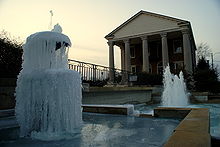 Though winters in the state are usually mild, nightly freezing occurs frequently in the North Alabama region. This is shown in this picture taken at the Old State Bank in Decatur during early January.
Though winters in the state are usually mild, nightly freezing occurs frequently in the North Alabama region. This is shown in this picture taken at the Old State Bank in Decatur during early January.
South Alabama reports many thunderstorms. The Gulf Coast, around Mobile Bay, averages between 70 and 80 days per year with thunder reported. This activity decreases somewhat further north in the state, but even the far north of the state reports thunder on about 60 days per year. Occasionally, thunderstorms are severe with frequent lightning and large hail – the central and northern parts of the state are most vulnerable to this type of storm. Alabama ranks seventh in the number of deaths from lightning and ninth in the number of deaths from lightning strikes per capita.[47]
Alabama, along with Kansas, has the most reported EF5 tornadoes of any state – according to statistics from the National Climatic Data Center for the period January 1, 1950, to October 31, 2006.[48] Several long – tracked F5 tornadoes have contributed to Alabama reporting more tornado fatalities than any other state, even surpassing Texas which has a much larger area within Tornado Alley. The state suffered damage in the Super Outbreak of April 1974, and the April 25–28, 2011 tornado outbreak.
The peak season for tornadoes varies from the northern to southern parts of the state. Alabama is one of the few places in the world that has a secondary tornado season in November and December, along with the spring severe weather season. The northern part of the state — along the Tennessee Valley — is one of the areas in the U.S. most vulnerable to violent tornadoes. The area of Alabama and Mississippi most affected by tornadoes is sometimes referred to as Dixie Alley, as distinct from the Tornado Alley of the Southern Plains.
Winters are generally mild in Alabama, as they are throughout most of the southeastern United States, with average January low temperatures around 40 °F (4 °C) in Mobile and around 32 °F (0 °C) in Birmingham. Although snow is a rare event in much of Alabama, areas of the state north of Montgomery may receive a dusting of snow a few times every winter, with an occasional moderately heavy snowfall every few years. Historic snowfall events include New Year's Eve 1963 snowstorm and the 1993 Storm of the Century. The annual average snowfall for the Birmingham area is 2 inches (51 mm) per year. In the southern Gulf coast, snowfall is less frequent, sometimes going several years without any snowfall.
Monthly normal high and low temperatures for various Alabama cities [°F (°C)] Month Jan Feb Mar Apr May Jun Jul Aug Sep Oct Nov Dec Year Huntsville Average high 48.9
(9.4)54.6
(12.6)63.4
(17.4)72.3
(22.4)79.6
(26.4)86.5
(30.3)89.4
(31.9)89.0
(31.7)83.0
(28.3)72.9
(22.7)61.6
(16.4)52.4
(11.3)71.1
(21.7)Average low 30.7
(-0.7)34.0
(1.1)41.2
(5.1)48.4
(9.1)57.5
(14.2)65.4
(18.6)69.5
(20.8)68.1
(20.1)61.7
(16.5)49.6
(9.8)40.7
(4.8)33.8
(1.0)50.1
(10.1)Birmingham Average high 52.8
(11.6)58.3
(14.6)66.5
(19.2)74.1
(23.4)81.0
(27.2)87.5
(30.8)90.6
(32.6)90.2
(32.3)84.6
(29.2)74.9
(23.8)64.5
(18.1)56.0
(13.3)73.4
(23.0)Average low 32.3
(0.2)35.4
(1.9)42.4
(5.8)48.4
(9.1)57.6
(14.2)65.4
(18.6)69.7
(20.9)68.9
(20.5)63.0
(17.2)50.9
(10.5)41.8
(5.4)35.2
(1.8)50.9
(10.5)Montgomery Average high 57.6
(14.2)62.4
(16.9)70.5
(21.4)77.5
(25.3)84.6
(29.2)90.6
(32.6)92.7
(33.7)92.2
(33.4)87.7
(30.9)78.7
(25.9)68.7
(20.4)60.3
(15.7)77.0
(25.0)Average low 35.5
(1.9)38.6
(3.7)45.4
(7.4)52.1
(11.2)60.1
(15.6)67.3
(19.6)70.9
(21.6)70.1
(21.2)64.9
(18.3)52.2
(11.2)43.5
(6.4)37.6
(3.1)53.2
(11.8)Mobile Average high 60.7
(15.9)64.5
(18.1)71.2
(21.8)77.4
(25.2)84.2
(29.0)89.4
(31.9)91.2
(32.9)90.8
(32.7)86.8
(30.4)79.2
(26.2)70.1
(21.2)62.9
(17.2)77.4
(25.2)Average low 39.5
(4.2)42.4
(5.8)49.2
(9.6)54.8
(12.7)62.8
(17.1)69.2
(20.7)71.8
(22.1)71.7
(22.0)67.6
(19.8)56.3
(13.5)47.8
(8.8)41.6
(5.3)56.2
(13.4)Source: NOAA[49][50][51][52] Demographics
Main article: Demographics of AlabamaHistorical populations Census Pop. %± 1800 1,250 — 1810 9,046 623.7% 1820 127,901 1,313.9% 1830 309,527 142.0% 1840 590,756 90.9% 1850 771,623 30.6% 1860 964,201 25.0% 1870 996,992 3.4% 1880 1,262,505 26.6% 1890 1,513,401 19.9% 1900 1,828,697 20.8% 1910 2,138,093 16.9% 1920 2,348,174 9.8% 1930 2,646,248 12.7% 1940 2,832,961 7.1% 1950 3,061,743 8.1% 1960 3,266,740 6.7% 1970 3,444,165 5.4% 1980 3,893,888 13.1% 1990 4,040,587 3.8% 2000 4,447,100 10.1% 2010 4,779,736 7.5% Sources: 1910-2010[53] The United States Census Bureau, as of July 1, 2008, estimated Alabama's population at 4,661,900,[1] which represents an increase of 214,545, or 4.8%, since the last census in 2000.[54] This includes a natural increase since the last census of 121,054 people (that is 502,457 births minus 381,403 deaths) and an increase due to net migration of 104,991 people into the state.[54] Immigration from outside the United States resulted in a net increase of 31,180 people, and migration within the country produced a net gain of 73,811 people.[54] The state had 108,000 foreign-born (2.4% of the state population), of which an estimated 22.2% were illegal immigrants (24,000).
The center of population of Alabama is located in Chilton County, outside of the town of Jemison.[55]
Race and ancestry
According to the 2010 U.S. Census, Alabama had a population of 4,779,736. In terms of race and ethnicity, the state was 68.5% White (67.0% Non-Hispanic White Alone), 26.2% Black or African American, 0.6% American Indian and Alaska Native, 1.1% Asian, 0.1% Native Hawaiian and Other Pacific Islander, 2.0% from Some Other Race, and 1.5% from Two or More Races. Hispanics or Latinos of any race made up 3.9% of the population.[56]
The largest reported ancestry groups in Alabama are: African American (26.2%), English (23.6%), Irish (7.7%), German (5.7%), and Scots-Irish (2.0%).[57][58][59] Those citing "American" ancestry in Alabama are of overwhelmingly English extraction, however most English Americans identify simply as having American ancestry because their roots have been in North America for so long, in many cases since the early 1600s. Demographers estimate that a minimum of 20-23% of people in Alabama are of predominantly English ancestry and state that the figure is probably much higher. In the 1980 census, 41% of the people in Alabama cited that they were of English ancestry, making them the largest ethnic group at the time.[60][61][62][63][64] There are also many more people in Alabama of Scots-Irish origins than are self-reported.[65] Many people in Alabama claim Irish ancestry because of the term "Scots-Irish", but most of the time in Alabama this term is used for those with Scottish roots, rather than Irish.[66]
In 1984, under the Davis–Strong Act, Alabama established a state Indian Commission and officially recognized seven American Indian tribes, including the Echota Cherokee Tribe of Alabama, which is a 501 (c3) group. It is made up of descendants of the Chickamauga Cherokee and others who managed to evade Indian Removal in the 1830s. Working with Auburn University, the tribe has begun a revival of the Cherokee language.
Religion
Alabama is located in the middle of the Bible Belt. A majority of people in Alabama today identify as Protestant. As of 2000, the three largest denominational groups in Alabama are Evangelical Protestant, Mainline Protestant, and Catholic. The Southern Baptist Convention has the highest number of adherents in Alabama with 1,380,121, followed by the United Methodist Church with 327,734 members, and the Catholic Church with 150,647 adherents.[67]
In a 2007 survey, nearly 70% of respondents could name all four of the Christian Gospels. Of those who indicated a religious preference, 59% said they possessed a "full understanding" of their faith and needed no further learning.[68] In a 2007 poll, 92% of Alabamians reported having at least some confidence in churches in the state.[69][70] In the 2008 American Religious Identification Survey, 80% of Alabama respondents reported their religion as Christian (other than Catholic,) 6% as Catholic, and 11% as having no religion at all.[71]
Health
A Centers for Disease Control and Prevention study showed that Alabama was one of the worst in the country for obesity with most counties having over 29% of adults obese, except for ten which exceeded 26%.[72] Residents were least likely of any state in the nation to exercise.[73] Alabama has one of the highest incidents of adult onset diabetes in the country, exceeding 10% of adults.[74][75]
Economy
The state has invested in aerospace, education, health care, banking, and various heavy industries, including automobile manufacturing, mineral extraction, steel production and fabrication.
According to the United States Bureau of Economic Analysis, the 2008 total gross state product was $170 billion, or $29,411 per capita. Alabama's 2008 GDP increased 0.7% from the previous year. The single largest increase came in the area of information.[76] In 1999, per capita income for the state was $18,189.[77]
As of September 2010, the state's unemployment rate is 8.9%.[78]
Largest employers
According to the Birmingham Business Journal, the five employers which employs the most employees in Alabama as of 2011 were:[79]
Employer Number of employees Redstone Arsenal 25,373 University of Alabama at Birmingham (includes UAB Hospital) 18,750 Maxwell Air Force Base 12,280 State of Alabama 9,500 Mobile County Public School System 8,100 Agriculture
Alabama's agricultural outputs include poultry and eggs, cattle, plant nursery items, peanuts, cotton, grains such as corn and sorghum, vegetables, milk, soybeans, and peaches. Although known as "The Cotton State", Alabama ranks between eighth and tenth in national cotton production, according to various reports,[80][81] with Texas, Georgia and Mississippi comprising the top three.
Industry
Alabama's industrial outputs include iron and steel products (including cast-iron and steel pipe); paper, lumber, and wood products; mining (mostly coal); plastic products; cars and trucks; and apparel. Also, Alabama produces aerospace and electronic products, mostly in the Huntsville area, location of NASA's George C. Marshall Space Flight Center and the U.S. Army Aviation and Missile Command, headquartered at Redstone Arsenal.
Most Alabama's economic growth is due to the state's expanding automotive manufacturing industry. Located in the state are Honda Manufacturing of Alabama, Hyundai Motor Manufacturing Alabama, Mercedes-Benz U.S. International, and Toyota Motor Manufacturing Alabama, as well as their various suppliers. Since 1993, the automobile industry has generated more than 67,800 new jobs in the state. Alabama currently ranks 4th in the nation in automobile output.[82]
Steel producers Nucor, SSAB, ThyssenKrupp, and U.S. Steel have facilities in Alabama and employ over 10,000 people. In May 2007, German steelmaker ThyssenKrupp selected Alabama for a $3.7 billion steel production plant, with the promise of 2,700 permanent jobs.[83] When ThyssenKrupp's new facilities reach full production capacity, Alabama is expected to become the third largest steel producing state in the country behind Indiana and Pennsylvania.[84]
The Hunt Refining Company, a subsidiary of Hunt Consolidated, Inc., is based in Tuscaloosa and operates a refinery there. The company also operates terminals in Mobile, Melvin, and Moundville.[85] JVC America, Inc., a wholly owned subsidiary of JVC Americas Corp., operates an optical disc replication and packaging plant in Tuscaloosa.[86]
Michelin North America operated a 1,000,000 square feet (9.3 ha) BFGoodrich Tire manufacturing plant in Opelika from 1963 to 2009, when it shut down.[87] GAF Materials Corporation formerly operated a plant in Mobile, but ceased production operations in 2010. The plant had previously been idled in 2007 before resuming in 2008 and may reopen in the future once demand recovers.[88]
Tourism
An estimated 100,000 tourists annually from other countries visit the state, including from Canada, England, Germany and Japan. In 2006, 22.3 million tourists spent $8.3 billion providing an estimated 162,000 jobs in the state.[89][90][91]
Health
UAB Hospital is the only Level I trauma center in Alabama.[92][93] UAB is the largest employer in Alabama, with a workforce of about 20,000.
Banking
Alabama has the headquarters of Regions Financial Corporation, BBVA Compass and Superior Bancorp. Birmingham-based Compass Banchshares was acquired by Spanish-based BBVA in September 2007, although the headquarters of BBVA Compass remains in Birmingham. In November 2006, Regions Financial completed its merger with AmSouth Bancorporation, which was also headquartered in Birmingham. SouthTrust Corporation, another large bank headquartered in Birmingham, was acquired by Wachovia in 2004 for $14.3 billion. The city still has major operations for Wachovia and its now post-operating bank Wells Fargo, which includes a regional headquarters, a operations center campus and a $400 million dollar data center. Nearly a dozen smaller banks are also headquartered in the Birmingham, such as Superior Bancorp, ServisFirst and New South Federal Savings Bank. Birmingham also serves as the headquarters for several large investment management companies, including Harbert Management Corporation.
Electronics
Telecommunications provider AT&T, formerly BellSouth, also has a major presence in Alabama with several large offices in Birmingham. The company has over 6,000 employees and more than 1,200 contract employees.
Many commercial technology companies are headquartered in Huntsville, such as the network access company ADTRAN, computer graphics company Intergraph, design and manufacturer of IT infrastructure Avocent, and telecommunications provider Deltacom. Cinram manufactures and distributes 20th Century Fox DVDs and Blu-ray Discs out of their Huntsville plant.
Construction
Rust International has grown to include Brasfield & Gorrie, BE&K, Hoar Construction and B.L. Harbert International, which all routinely are included in the Engineering News-Record lists of top design, international construction, and engineering firms. (Rust International was acquired in 2000 by Washington Group International, which was in turn acquired by San-Francisco based URS Corporation in 2007.)
Transportation
The Port of Mobile, Alabama's only saltwater port, is a busy seaport on the Gulf of Mexico with inland waterway access to the Midwest by way of the Tennessee-Tombigbee Waterway. The Port of Mobile is currently the 9th-largest by tonnage in the United States.[94]
Barge transportation in and out of the Port of Tuscaloosa and other commercial navigation make the Black Warrior River useful in the state of Alabama.
Law and government
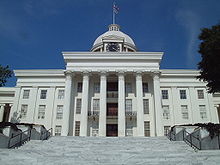 The State Capitol, built in 1850
The State Capitol, built in 1850
State government
Main article: Government of AlabamaThe foundational document for Alabama's government is the Alabama Constitution, which was ratified in 1901. At almost 800 amendments and 310,000 words, it is the world's longest constitution and is roughly forty times the length of the U.S. Constitution.[95][96] There is a significant movement to rewrite and modernize Alabama's constitution.[97] This movement is based upon the fact that Alabama's constitution highly centralizes power in Montgomery and leaves practically no power in local hands. Any policy changes proposed around the state must be approved by the entire Alabama legislature and, frequently, by state referendum. One criticism of the current constitution claims that its complexity and length were intentional to codify segregation and racism.
Alabama is divided into three equal branches: The legislative branch is the Alabama Legislature, a bicameral assembly composed of the Alabama House of Representatives, with 105 members, and the Alabama Senate, with 35 members. The Legislature is responsible for writing, debating, passing, or defeating state legislation.
The executive branch is responsible for the execution and oversight of laws. It is headed by the Governor of Alabama. Other members of executive branch include the cabinet, the Attorney General of Alabama, the Alabama Secretary of State, the Alabama Commissioner of Agriculture and Industries, the Alabama State Treasurer, and the State Auditor of Alabama.
The judicial branch is responsible for interpreting the Constitution and applying the law in state criminal and civil cases. The highest court is the Supreme Court of Alabama.
Taxes
Alabama levies a 2, 4, or 5 percent personal income tax, depending upon the amount earned and filing status. Taxpayers are not allowed to deduct their federal income tax from their Alabama state tax, but can deduct federal Social Security and Medicare taxes.
The state's general sales tax rate is 4%.[98] The collection rate could be substantially higher, depending upon additional city and county sales taxes. For example, the total sales tax rate in Mobile is 10% and there is an additional restaurant tax of 1%, which means that a diner in Mobile would pay a 11% tax on a meal. Sales and excise taxes in Alabama account for 51% of all state and local revenue, compared with an average of about 36% nationwide. Alabama is also one of the few remaining states that levies a tax on food and medicine. Alabama's income tax on poor working families is among the nation's very highest.[99] Alabama is the only state that levies income tax on a family of four with income as low as $4,600, which is barely one-quarter of the federal poverty line.[99] Alabama's threshold is the lowest among the 41 states and the District of Columbia with income taxes.[99]
The corporate income tax rate is currently 6.5%. The overall federal, state, and local tax burden in Alabama ranks the state as the second least tax-burdened state in the country.[100] Property taxes are the lowest in the United States. The current state constitution requires a voter referendum to raise property taxes.
Since Alabama's tax structure largely depends on consumer spending, it is subject to high variable budget structure. For example, in 2003 Alabama had an annual budget deficit as high as $670 million.
Local and county government
Alabama has 67 counties. Each county has its own elected legislative branch, usually called the County Commission, which usually also has executive authority in the county. Because of the restraints placed in the Alabama Constitution, all but seven counties (Jefferson, Lee, Mobile, Madison, Montgomery, Shelby, and Tuscaloosa) in the state have little to no home rule. Instead, most counties in the state must lobby the Local Legislation Committee of the state legislature to get simple local policies such as waste disposal to land use zoning.
Alabama is an alcoholic beverage control state; the government holds a monopoly on the sale of alcohol. However, counties can declare themselves "dry"; the state does not sell alcohol in those areas.
Rank County Population
(2010 Census)Seat Largest city 1 Jefferson 658,466 Birmingham Birmingham 2 Mobile 412,992 Mobile Mobile 3 Madison 334,811 Huntsville Huntsville 4 Montgomery 229,363 Montgomery Montgomery 5 Shelby 195,085 Columbiana Hoover (part)
Alabaster6 Tuscaloosa 194,656 Tuscaloosa Tuscaloosa 7 Baldwin 182,265 Bay Minette Daphne 8 Lee 140,247 Opelika Auburn 9 Morgan 119,490 Decatur Decatur 10 Calhoun 118,572 Anniston Anniston Politics
Further information: Political party strength in Alabama Alabama Governor Robert Bentley
Alabama Governor Robert Bentley
The current governor of the state is Republican Robert Bentley. The lieutenant governor is Republican Kay Ivey. The Chief Justice of the Alabama Supreme Court is Democrat Sue Bell Cobb. The Republican Party currently holds a majority in both houses of the Legislature. The Legislature has the power to override a gubernatorial veto by a simple majority (most state Legislatures require a two-thirds majority to override a veto).
During Reconstruction following the American Civil War, Alabama was occupied by federal troops of the Third Military District under General John Pope. In 1874, the political coalition known as the Redeemers took control of the state government from the Republicans, in part by suppressing the African American vote.
After 1890, a coalition of whites passed laws to segregate and disenfranchise black residents, a process completed in provisions of the 1901 constitution. Provisions which disfranchised African Americans also disfranchised poor whites, however. By 1941 more whites than blacks had been disfranchised: 600,000 to 520,000, although the impact was greater on the African-American community, as almost all of its citizens were disfranchised.
From 1901 through the 1960s, the state did not redraw election districts as population grew and shifted within the state. The result was a rural minority that dominated state politics until a series of court cases required redistricting in 1972.
Alabama state politics gained nationwide and international attention in the 1950s and 1960s during the American Civil Rights Movement, when majority whites bureaucratically, and at times, violently resisted protests for electoral and social reform. George Wallace, the state's only four-term governor, was a controversial figure. Only with the passage of the Federal Civil Rights Act of 1964[32] and Voting Rights Act of 1965 did African Americans regain suffrage and other civil rights.
In 2007, the Alabama Legislature passed, and Republican Governor Bob Riley signed, a resolution expressing "profound regret" over slavery and its lingering impact. In a symbolic ceremony, the bill was signed in the Alabama State Capitol, which housed Congress of the Confederate States of America.[101]
State elections
With the disfranchisement of African Americans, the state became part of the "Solid South", a one-party system in which the Democratic Party became essentially the only political party in every Southern state. For nearly 100 years, local and state elections in Alabama were decided in the Democratic Party primary, with generally only token Republican challengers running in the General Election.
Developments in the 1986 Democratic primary election led to the election of the first Republican Governor in more than 100 years and started Republicans on the road to political dominance in the state. One million voters cast ballots in the 1986 Democratic primary. The then-incumbent Lieutenant Governor, Bill Baxley, lost the Democratic nomination for Governor by approximately 8,000 votes to then fellow Democratic Attorney General Charles Graddick. The state Democratic party's five-member election contest committee invalidated the primary election result claiming that thousands of Republicans had "illegally" voted in the Democratic primary for Graddick and as a result they removed Graddick from the ballot. The Democratic Party then placed Baxley's name on the ballot as the Democratic candidate instead of Graddick. The voters of the state revolted at what they perceived as disenfranchisement of their right to vote and elected the Republican challenger Guy Hunt as Governor.[102] Hunt had been nominated in a statewide Republican primary that had 28,000 participants compared to the 1,000,000 plus of the Democratic primary. That November Hunt became the first Republican Governor elected in Alabama since Reconstruction when he won 57% of the vote statewide against Baxley.
Since 1986, Republicans have won six of the seven Governors elections and become increasingly competitive in Alabama politics at many levels. They currently control both seats in the U.S. Senate and six out of the state's seven congressional seats.
Republicans hold all nine seats on the Alabama Supreme Court [103] and all ten seats on the state appellate courts. Until 1994, no Republicans held any of the court seats. This change also began, likely in part, due to the same perception by voters of Democratic party efforts to disenfranchise voters again in 1994. In that general election, the then-incumbent Chief Justice of Alabama, Sonny Hornsby, refused to leave office after losing the election by approximately 3,000 votes to Republican Perry Oliver Hooper, Sr. Hornsby sued Alabama in court and defiantly remained in office for more than a year before finally giving up the seat after losing in court. This ultimately would lead to a collapse of support for Democrats at the ballot box in the next three or four election cycles and ultimately losing the last of the nineteen court seats following the resignation of the last Democrat in August, 2011.
Today, Republicans also hold all seven of the statewide elected executive branch offices. Republicans also hold six of the eight elected seats on the Alabama State Board of Education. In 2010, Republicans took large majorities of both chambers of the state legislature giving them control of that body for the first time in 136 years. However, Democrats hold one of the three seats on the Alabama Public Service Commission.[104][105][106]
Only two Republican Lieutenant Governors have been elected since Reconstruction, Steve Windom and Kay Ivey, the current Lieutenant Governor. Windom served as Lt. Governor under Democratic Gov. Don Siegelman. Before 2011, the last time that Alabama had a governor and Lieutenant Governor of the same party was the period between 1983 and 1987 when George Wallace was serving his fourth term as governor and Bill Baxley was serving as Lieutenant Governor; both were Democrats.
In Alabama, the members of the Legislature take office immediately after the November elections, but the statewide officials, such as the Governor, Lieutenant Governor, Attorney General, and other constitutional offices take office in the following January.[107]
Local elections
Many local offices (County Commissioners, Boards of Education, Tax Assessors, Tax Collectors, etc.) in the state are still held by Democrats. Local elections in most rural counties are generally decided in the Democratic primary and local elections in metropolitan and suburban counties are generally decided in the Republican Primary, although there are exceptions.[108][109]
Alabama's 67 County Sheriffs are elected in partisan races and Democrats still retain the majority of those posts. The current split is 42 Democrats, 24 Republicans, and 1 Independent (Choctaw).[110][Full citation needed] However, most of the Democratic sheriffs preside over rural and less populated counties and the majority of Republican sheriffs preside over more urban/suburban and heavily populated counties.[111] Two Alabama counties (Montgomery and Calhoun) with a population of over 100,000 have Democratic sheriffs and five Alabama counties with a population of under 75,000 have Republican sheriffs (Autauga, Coffee, Dale, Coosa, and Blount).[112] The state has one female sheriff (Morgan) and 9 African-American sheriffs.[113][Full citation needed]
Federal elections
Presidential elections results Year Republican Democratic State winner 2008 60.32% 1,266,546 38.80% 813,479 John McCain 2004 62.46% 1,176,394 36.84% 693,933 George W. Bush 2000 56.47% 944,409 41.59% 695,602 George W. Bush 1996 50.12% 769,044 43.16% 662,165 Bob Dole 1992 47.65% 804,283 40.88% 690,080 George Bush 1988 59.17% 815,576 39.86% 549,506 George Bush 1984 60.54% 872,849 38.28% 551,899 Ronald Reagan 1980 48.75% 654,192 47.45% 636,730 Ronald Reagan 1976 42.61% 504,070 55.73% 659,170 Jimmy Carter 1972 72.43% 728,701 25.54% 256,923 Richard Nixon 1968* 13.99% 146,923 18.72% 196,579 George Wallace (I) 1964 69.45% 479,085 30.55% 210,732 Barry Goldwater 1960 42.16% 237,981 56.39% 318,303 John F. Kennedy *State won by George Wallace
of the American Independent Party,
at 65.86%, or 691,425 votesFrom 1876 through 1956, Alabama supported only Democratic presidential candidates, by large margins. In 1960, the Democrats won with John F. Kennedy on the ballot, but the Democratic electors from Alabama gave 6 of their 11 electoral votes as a protest to Harry Byrd. In 1964, Republican Barry Goldwater carried the state.
In the 1968 presidential election, Alabama supported native son and American Independent Party candidate George Wallace over both Richard Nixon and Hubert Humphrey. Wallace was the official Democratic candidate in Alabama, while Humphrey was listed as the "National Democratic".[114] In 1976, Democratic candidate Jimmy Carter from Georgia carried the state, the region, and the nation, but Democratic control of the region slipped after that.
Since 1980, conservative Alabama voters have increasingly voted for Republican candidates at the Federal level, especially in Presidential elections. By contrast, Democratic candidates have been elected to many state-level offices and until 2010 comprised a longstanding majority in the Alabama Legislature; see Dixiecrat.
In 2004, George W. Bush won Alabama's nine electoral votes by a margin of 25 percentage points with 62.5% of the vote, mostly white voters. The 11 counties that voted Democratic were Black Belt counties, where African Americans are the majority racial group.
The state's two U.S. senators are Jefferson B. Sessions III and Richard C. Shelby, both Republicans.
In the U.S. House of Representatives, the state is represented by seven members, six of whom are Republicans: (Jo Bonner, Mike D. Rogers, Robert Aderholt, Morris J. Brooks, Martha Roby, and Spencer Bachus) and one Democrat: Terri Sewell).
Further information: United States presidential election in Alabama, 2004Education
Main article: Education in AlabamaPrimary and secondary education
Public primary and secondary education in Alabama is under the overview of the Alabama State Board of Education as well as local oversight by 67 county school boards and 60 city boards of education. Together, 1,541 individual schools provide education for 743,364 elementary and secondary students.[115]
Public school funding is appropriated through the Alabama Legislature through the Education Trust Fund. In FY 2006–2007, Alabama appropriated $3,775,163,578 for primary and secondary education. That represented an increase of $444,736,387 over the previous fiscal year.[115] In 2007, over 82 percent of schools made adequate yearly progress (AYP) toward student proficiency under the National No Child Left Behind law, using measures determined by the State of Alabama. In 2004, 23 percent of schools met AYP.[116]
While Alabama's public education system has improved, it lags behind in achievement compared to other states. According to U.S. Census data, Alabama's high school graduation rate – 75% – is the second lowest in the United States (after Mississippi).[117] The largest educational gains were among people with some college education but without degrees.[118]
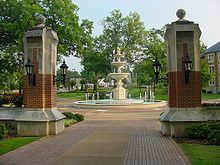 Harrison Plaza at the University of North Alabama in Florence. The school was chartered as LaGrange College by the Alabama Legislature in 1830.
Harrison Plaza at the University of North Alabama in Florence. The school was chartered as LaGrange College by the Alabama Legislature in 1830.
Colleges and universities
Main article: List of colleges and universities in AlabamaAlabama's programs of higher education include 14 four-year public universities, two-year community colleges, and 17 private, undergraduate and graduate universities. In the state are two medical schools (University of Alabama at Birmingham and University of South Alabama), two veterinary colleges (Auburn University and Tuskegee University), a dental school (University of Alabama at Birmingham), an optometry college (University of Alabama at Birmingham), two pharmacy schools (Auburn University and Samford University), and five law schools (University of Alabama School of Law, Birmingham School of Law, Cumberland School of Law, Miles Law School, and the Thomas Goode Jones School of Law). Public, post-secondary education in Alabama is overseen by the Alabama Commission on Higher Education. Colleges and universities in Alabama offer degree programs from two-year associate degrees to 16 doctoral level programs.[119][120]
The largest single campus is the University of Alabama, located in Tuscaloosa, with 31,747 enrolled for fall 2011.[121] Troy University is the largest institution in the state, enrolling 29,689 students (as of 2010) across four Alabama campuses (Troy, Dothan, Montgomery, and Phenix City), as well as sixty learning sites in seventeen other states and eleven other countries. The oldest institutions are the public University of North Alabama in Florence and the Catholic Church-affiliated Spring Hill College in Mobile, both founded in 1830.[122][123]
Accreditation of academic programs is through the Southern Association of Colleges and Schools (SACS) as well as other subject-focused national and international accreditation agencies such as the Association for Biblical Higher Education (ABHE),[124] the Council on Occupational Education (COE),[125] and the Accrediting Council for Independent Colleges and Schools (ACICS).[126]
According to the 2011 U.S. News and World Report, Alabama had three universities ranked in the top 100 Public Schools in America (University of Alabama at 31, Auburn University at 36, and University of Alabama at Birmingham at 73).[127]
Sports
Professional sports teams
Main article: List of professional sports teams in AlabamaAlabama has several minor league professional teams including four minor league baseball teams.
Club City Sport League Venue Notes Alabama Hammers Huntsville Arena football Southern Indoor Football League Von Braun Center Birmingham Barons Birmingham Baseball Southern League Regions Park Huntsville Havoc Huntsville Ice Hockey Southern Professional Hockey League Von Braun Center Huntsville Stars Huntsville Baseball Southern League Joe W. Davis Stadium Mobile BayBears Mobile Baseball Southern League Hank Aaron Stadium Montgomery Biscuits Montgomery Baseball Southern League Montgomery Riverwalk Stadium Rocket City United Huntsville Soccer National Premier Soccer League Madison City Schools Stadium Tennessee Valley Tigers Huntsville Football Independent Women's Football League Milton Frank Stadium replaced the Alabama Renegades Venues
Alabama has four of the world's largest stadiums by seating capacity: Talladega Superspeedway in Talladega, Bryant-Denny Stadium in Tuscaloosa, Jordan-Hare Stadium in Auburn and Legion Field in Birmingham.
The Talladega Superspeedway motorsports complex hosts a series of NASCAR events. It has a seating capacity of 143,000 and is the thirteenth largest stadium in the world and sixth largest stadium in America. Bryant-Denny Stadium serves as the home of the University of Alabama football team has a seating capacity of 101,821. It is the fifth largest stadium in America and the eighth largest non-racing stadium in the world. Jordan-Hare Stadium is the home field of the Auburn University football team and has a seating capacity of 87,451. It is the twelfth largest college football stadium in America. Legion Field is home for the UAB Blazers football program and the Papajohns.com Bowl. It seats 71,594.[128][129]
Ladd-Peebles Stadium in Mobile serves as the home of the NCAA Senior Bowl, GoDaddy.com Bowl, Alabama-Mississippi All Star Classic and home of the University of South Alabama football team. Ladd-Peebles Stadium opened in 1948 and seats 40,646.[130]
In 2009, Bryant-Denny Stadium and Jordan-Hare Stadium became the homes of the Alabama High School Athletic Association state football championship games, known as the Super Six. Bryant-Denny hosts the Super Six in odd-numbered years, with Jordan-Hare taking the games in even-numbered years. Previously, the Super Six was held at Legion Field in Birmingham.[131]
Transportation
Air transportation
Main article: Aviation in AlabamaMajor airports in Alabama include Birmingham-Shuttlesworth International Airport (BHM), Huntsville International Airport (HSV), Dothan Regional Airport (DHN), Mobile Regional Airport (MOB), Montgomery Regional Airport (MGM), Muscle Shoals – Northwest Alabama Regional Airport (MSL), Tuscaloosa Regional Airport (TCL), and Pryor Field Regional Airport (DCU).
Rail
For rail transport, Amtrak schedules the Crescent, a daily passenger train, running from New York to New Orleans with stops at Anniston, Birmingham, and Tuscaloosa.
Roads
Alabama has five major interstate roads that cross the state: I-65 runs north–south roughly through the middle of the state; I-59/I-20 travels from the central west border to Birmingham, where I-59 continues to the north-east corner of the state and I-20 continues east towards Atlanta; I-85 originates in Montgomery and runs east-northeast to the Georgia border, providing a main thoroughfare to Atlanta; and I-10 traverses the southernmost portion of the state, running from west to east through Mobile. Another interstate road, I-22, is currently under construction. When completed around 2012 it will connect Birmingham with Memphis, Tennessee. Several U.S.Highways also pass through the state, such as US 11, US 29, US 31, US 43, US 72, US 78, US 80, US 82, US 84, US 90, US 98, US 231, US 278, US 280, and US 431.
There are four toll roads in the state: Alabama River Parkway in Montgomery; Black Warrior Parkway in Tuscaloosa; Emerald Mountain Expressway in Montgomery; Foley Beach Express in Foley; Montgomery Expressway in Montgomery and four toll bridges: Alabama River Parkway Bridge in Montgomery; Black Warrior Parkway Bridge in Tuscaloosa; Emerald Mountain Expressway Bridge in Montgomery; and Foley Beach Express Bridge in Foley.
In March 2011, Alabama ranked among the top five "Worst" states on the American State Litter Scorecard, for overall poor effectiveness and quality of its statewide public space cleanliness—primarily roadway and adjacent litter removals—from state and related efforts.[132]
Ports
Alabama has one seaport, in Mobile on the Gulf of Mexico. The state's other ports are on rivers with access to the Gulf.
Water ports of Alabama, listed from north to south:
Port name Location Connected to Port of Florence Florence/Muscle Shoals, on Pickwick Lake Tennessee River Port of Decatur Decatur, on Wheeler Lake Tennessee River Port of Guntersville Guntersville, on Lake Guntersville Tennessee River Port of Birmingham Birmingham, on Black Warrior River Tenn-Tom Waterway Port of Tuscaloosa Tuscaloosa, on Black Warrior River Tenn-Tom Waterway Port of Montgomery Montgomery, on Woodruff Lake Alabama River Port of Mobile Mobile, on Mobile Bay Gulf of Mexico See also
- Outline of Alabama
- Index of Alabama-related articles
- List of people from Alabama
- National Register of Historic Places listings in Alabama
References
- ^ a b "Annual Estimates of the Resident Population for the United States, Regions, States, and Puerto Rico: April 1, 2000 to July 1, 2008". United States Census Bureau. http://www.census.gov/popest/states/tables/NST-EST2008-01.csv. Retrieved 2009-02-01.
- ^ "Cheehahaw". NGS data sheet. U.S. National Geodetic Survey. http://www.ngs.noaa.gov/cgi-bin/ds_mark.prl?PidBox=DG3595. Retrieved October 20, 2011.
- ^ a b "Elevations and Distances in the United States". United States Geological Survey. 2001. http://egsc.usgs.gov/isb/pubs/booklets/elvadist/elvadist.html. Retrieved October 21, 2011.
- ^ Elevation adjusted to North American Vertical Datum of 1988.
- ^ "Alabama Quick Facts". State and County Quick Facts. U.S. Census Bureau. http://quickfacts.census.gov/qfd/states/01000.html. Retrieved December 30, 2010.
- ^ a b c "George Mason University, United States Election Project: Alabama Redistricting Summary, accessed March 10, 2008". Web.archive.org. Archived from the original on 2007-10-17. http://web.archive.org/web/20071017192719/http://elections.gmu.edu/Redistricting/AL.htm. Retrieved 2010-10-24.
- ^ a b c Read, William A. (1984). Indian Place Names in Alabama. University of Alabama Press. ISBN 0-8173-0231-X. OCLC 10724679.
- ^ Sylestine, Cora; Hardy; Heather; and Montler, Timothy (1993). Dictionary of the Alabama Language. Austin: University of Texas Press. ISBN 0-292-73077-2. OCLC 26590560. http://www.ling.unt.edu/~montler/Alabama/.
- ^ a b c Rogers, William W.; Robert D. Ward, Leah R. Atkins, Wayne Flynt (1994). Alabama: the History of a Deep South State. University of Alabama Press. ISBN 0-8173-0712-5. OCLC 28634588.
- ^ a b c d e f g h "Alabama: The State Name". All About Alabama. Alabama Department of Archives and History. http://www.archives.alabama.gov/statenam.html. Retrieved 2007-08-02.
- ^ a b Wills, Charles A. (1995). A Historical Album of Alabama. The Millbrook Press. ISBN 1-56294-591-2. OCLC 32242468.
- ^ Griffith, Lucille (1972). Alabama: A Documentary History to 1900. University of Alabama Press. ISBN 0-8173-0371-5. OCLC 17530914.
- ^ The use of state names derived from Native American languages is common; an estimated 27 states have names of Native American origin. Weiss, Sonia (1999). The Complete Idiot's Guide to Baby Names. Mcmillan USA. ISBN 0-02-863367-9. OCLC 222611214.
- ^ a b Swanton, John R. (1953). "The Indian Tribes of North America". Bureau of American Ethnology Bulletin 145: 153–174. http://www.hiddenhistory.com/PAGE3/swsts/alabam-1.htm. Retrieved 2007-08-02.
- ^ a b Swanton, John R. (1937). "Review of Read, Indian Place Names of Alabama". American Speech 12 (12): 212–215. doi:10.2307/452431. JSTOR 452431.
- ^ "Alabama". The New York Times Almanac 2004. The New York Times. 2006-08-11. http://travel2.nytimes.com/2004/07/15/travel/NYT_ALMANAC_US_ALABAMA.html. Retrieved 2006-09-23.
- ^ Welch, Paul D. (1991). Moundville's Economy. University of Alabama Press. ISBN 0-8173-0512-2. OCLC 21330955.
- ^ Walthall, John A. (1990). Prehistoric Indians of the Southeast-Archaeology of Alabama and the Middle South. University of Alabama Press. ISBN 0-8173-0552-1. OCLC 26656858.
- ^ Townsend, Richard F. (2004). Hero, Hawk, and Open Hand. Yale University Press. ISBN 0-300-10601-7. OCLC 56633574.
- ^ edited by F. Kent Reilly III and James F. Garber ; foreword by Vincas P. Steponaitis. (2004). F. Kent Reilly and James Garber. ed. Ancient Objects and Sacred Realms. University of Texas Press. ISBN 978-0-292-71347-5. OCLC 70335213.
- ^ "Alabama Indian Tribes". Indian Tribal Records. AccessGenealogy.com. Updated 2006. http://www.accessgenealogy.com/native/alabama/. Retrieved 2006-09-23.
- ^ "Alabama State History". theUS50.com. http://www.theus50.com/alabama/. Retrieved 2006-09-23.
- ^ "Alabama Historical Association Marker Program: Washington County". Archives.state.al.us. http://www.archives.state.al.us/aha/markers/washington.html. Retrieved 2011-06-01.
- ^ "AL-Alabama". Landscapes and History by state. StateMaster.com. http://www.statemaster.com/graph-T/bac_sum. Retrieved 2006-09-23.
- ^ a b c "The Black Belt". Southern Spaces Internet Journal. Emory University. 2004-04-19. http://southernspaces.org/2004/black-belt. Retrieved 2006-09-23.
- ^ Montgomery: History - Early Days in Montgomery, Lafayette's Visit a Local Highlight
- ^ "13th Amendment to the U.S. Constitution: Abolition of Slavery (1865)". Historical Documents. HistoricalDocuments.com. 2005. http://www.historicaldocuments.com/13thAmendment.htm. Retrieved 2006-09-23.
- ^ J. Morgan Kousser.The Shaping of Southern Politics: Suffrage Restriction and the Establishment of the One-Party South, New Haven: Yale University Press, 1974
- ^ "A Blaine Amendment Update (July 00)". Schoolreport.com. http://www.schoolreport.com/schoolreport/articles/blaine_7_00.htm. Retrieved 2011-06-01.
- ^ a b Glenn Feldman. The Disfranchisement Myth: Poor Whites and Suffrage Restriction in Alabama. Athens: University of Georgia Press, 2004, p. 136.
- ^ "Birmingham". Bhamwiki. http://www.bhamwiki.com/w/Birmingham. Retrieved 2010-10-24.
- ^ a b "Civil Rights Act of 1964". Finduslaw.com. http://finduslaw.com/civil_rights_act_of_1964_cra_title_vii_equal_employment_opportunities_42_us_code_chapter_21. Retrieved 2010-10-24.
- ^ "Voting Rights". Civil Rights: Law and History. U.S.Department of Justice. 2002-01-09. Archived from the original on 2007-02-21. http://web.archive.org/web/20070221054512/http://www.usdoj.gov/kidspage/crt/voting.htm. Retrieved 2006-09-23.
- ^ "The New South Rises, Again". Civil Rights: Law and History. Southerner.net. Spring 1999. http://www.southerner.net/v1n1_99/coverstory1.html. Retrieved 2006-09-23.
- ^ "GCT-PH1-R. Population, Housing Units, Area, and Density (areas ranked by population): 2000". Geographic Comparison Table. U.S.Census Bureau. Census Year 2000. http://factfinder.census.gov/servlet/GCTTable?_bm=n&_lang=en&mt_name=DEC_2000_SF1_U_GCTPH1R_US9S&format=US-9S&_box_head_nbr=GCT-PH1-R&ds_name=DEC_2000_SF1_U&geo_id=01000US. Retrieved 2006-09-23.
- ^ a b c "The Geography of Alabama". Geography of the States. NetState.com. 2006-08-11. http://www.netstate.com/states/geography/al_geography.htm. Retrieved 2006-09-23.
- ^ "Elevations and Distances in the United States". U.S Geological Survey. April 29, 2005. http://erg.usgs.gov/isb/pubs/booklets/elvadist/elvadist.html#Highest. Retrieved November 3, 2006.
- ^ "NGS Data Sheet for Cheaha Mountain". U.S. National Geodetic Survey. http://www.ngs.noaa.gov/cgi-bin/ds_mark.prl?PidBox=DG3595. Retrieved 8 June 2011.
- ^ Alabama Forest Owner's Guide to Information Resources, Introduction, Alabamaforests.org
- ^ "Alabama County (geographies ranked by total population)". Geographic Comparison Table. U.S. Census Bureau. Census year 2000. http://factfinder.census.gov/servlet/GCTTable?_bm=y&-context=gct&-ds_name=DEC_2000_SF1_U&-mt_name=DEC_2000_SF1_U_GCTPH1R_ST2S&-CONTEXT=gct&-tree_id=4001&-redoLog=true&-geo_id=04000US01&-format=ST-2. Retrieved 2007-05-14.
- ^ "National Park Guide". Geographic Search. Washington, D.C: National Park Service – U.S. Department of the Interior. http://home.nps.gov/applications/parksearch/state.cfm?st=al. Retrieved 2006-09-23.
- ^ "National Forests in Alabama". USDA Forest Service. United States Department of Agriculture. http://www.fs.fed.us/r8/alabama/forests/. Retrieved 2008-10-05.
- ^ a b c "Wetumpka Impact Crater" Wetumpka Public Library. Retrieved August 21, 2007.
- ^ "The Wetumpka Astrobleme" by John C. Hall, Alabama Heritage, Fall 1996, Number 42.
- ^ Christopher M. Godfrey (2008-11-04). "Greenhouse effect and climate". Atmospheric Sciences. University of North Carolina, Asheville. http://facstaff.unca.edu/cgodfrey/courses/atms179/ppt/greenhouse.pdf.
- ^ a b "Alabama Climate". Britannica.com. http://www.britannica.com/eb/article-78303/Alabama. Retrieved 2010-10-24.
- ^ Lightning Fatalities, Injuries and Damages in the United States, 1990–2003. NLSI. Retrieved May 8, 2007.
- ^ Fujita scale. Tornadoproject.com. Retrieved September 3, 2007.
- ^ "Climatography of the United States No. 20 (1971–2000)" (PDF). National Oceanic and Atmospheric Administration. 2004. Archived from the original on 6 July 2011. http://www.webcitation.org/5zy9c24Md. Retrieved 6 July 2011.
- ^ "Climatography of the United States No. 20 (1971–2000)" (PDF). National Oceanic and Atmospheric Administration. 2004. Archived from the original on 6 July 2011. http://www.webcitation.org/5zy9gazEr. Retrieved 6 July 2011.
- ^ "Climatography of the United States No. 20 (1971–2000)" (PDF). National Oceanic and Atmospheric Administration. 2004. Archived from the original on 6 July 2011. http://www.webcitation.org/5zy9hg7e3. Retrieved 6 July 2011.
- ^ "Climatography of the United States No. 20 (1971–2000)" (PDF). National Oceanic and Atmospheric Administration. 2004. Archived from the original on 6 July 2011. http://www.webcitation.org/5zy9j4S0w. Retrieved 6 July 2011.
- ^ Resident Population Data. "Resident Population Data - 2010 Census". 2010.census.gov. http://2010.census.gov/2010census/data/apportionment-pop-text.php. Retrieved 2011-06-01.
- ^ a b c U. S. Census Bureau (2008-12-15). "Cumulative Estimates of the Components of Population Change for the United States, Regions and States: April 1, 2000 to July 1, 2008 (NST-EST2008-04)" (CSV). http://www.census.gov/popest/states/tables/NST-EST2008-04.csv. Retrieved 2009-01-16.
- ^ "Population and Population Centers by State – 2000". United States Census Bureau. http://www.census.gov/geo/www/cenpop/statecenters.txt. Retrieved 2008-12-03.
- ^ "American FactFinder". Factfinder2.census.gov. 2010-10-05. http://factfinder2.census.gov/faces/tableservices/jsf/pages/productview.xhtml?pid=DEC_10_PL_QTPL&prodType=table. Retrieved 2011-06-01.
- ^ "Data on selected ancestry groups". Docs.google.com. http://docs.google.com/viewer?a=v&q=cache:WJGw9z2RkkYJ:www.uen.org/Lessonplan/downloadFile.cgi%3Ffile%3D1041-6-15955-AF_Census_Data.pdf%26filename%3DAF_Census_Data.pdf+49,598,035&hl=en&gl=uk&pid=bl&srcid=ADGEESgyigzsjZP7yBWdThzodFWP_t7GiFtOGi5W12qTf5nLj_yFzQ0YIKJn2pSyS1TIT-ZjvBx0s057h5mpwrf39HOZmlg3VzoOdaoPrNTdS6x-0SbHnwGXfzVLkDYTyIg7k4E_Zsn8&sig=AHIEtbTzro9GQY6LB1-9ZG9n2r46Epyyaw. Retrieved 2011-06-01.
- ^ "1980 United States Census" (PDF). http://www.census.gov/population/censusdata/pc80-s1-10/tab02.pdf. Retrieved 2011-06-01.
- ^ "Alabama – Selected Social Characteristics in the United States: 2006–2008". Factfinder.census.gov. http://factfinder.census.gov/servlet/ADPTable?_bm=y&-geo_id=04000US01&-qr_name=ACS_2008_3YR_G00_DP3YR2&-ds_name=&-_lang=en&-redoLog=false. Retrieved 2010-10-24.
- ^ http://www.census.gov/population/www/censusdata/files/pc80-s1-10/tab03.pdf
- ^ Sharing the Dream: White Males in a Multicultural America By Dominic J. Pulera.
- ^ Reynolds Farley, 'The New Census Question about Ancestry: What Did It Tell Us?', Demography, Vol. 28, No. 3 (August 1991), pp. 414, 421.
- ^ Stanley Lieberson and Lawrence Santi, 'The Use of Nativity Data to Estimate Ethnic Characteristics and Patterns', Social Science Research, Vol. 14, No. 1 (1985), pp. 44-6.
- ^ Stanley Lieberson and Mary C. Waters, 'Ethnic Groups in Flux: The Changing Ethnic Responses of American Whites', Annals of the American Academy of Political and Social Science, Vol. 487, No. 79 (September 1986), pp. 82-86.
- ^ http://factfinder.census.gov/servlet/ADPTable?_bm=y&-geo_id=04000US01&-qr_name=ACS_2008_3YR_G00_DP3YR2&-ds_name=&-_lang=en&-redoLog=false
- ^ Census 2000 Map - Top U.S. Ancestries by County
- ^ "State Membership Reports". thearda.com. http://www.thearda.com/mapsReports/reports/state/01_2000.asp. Retrieved 2010-06-15.
- ^ Campbell, Kirsten (2007-03-25). "Alabama rates well in biblical literacy". Mobile Register (Advance Publications, Inc): p. A1.
- ^ "Confidence in State and Local Institutions Survey" (PDF). Capital Survey Research Center. Archived from the original on 2007-08-09. http://web.archive.org/web/20070809021852/http://www.myaea.org/PDFfile/Confidence+in+State+Institutions07.pdf. Retrieved 2007-06-02.
- ^ White, David (2007-04-01). "Poll says we feel good about state Trust in government, unlike some institutions, hasn't fallen". Birmingham News (Birmingham News): p. 13A.
- ^ Barry A. Kosmin and Ariela Keysar (2009). "AMERICAN RELIGIOUS IDENTIFICATION SURVEY (ARIS) 2008" (PDF). Hartford, Connecticut, USA: Trinity College. p. 20. http://b27.cc.trincoll.edu/weblogs/AmericanReligionSurvey-ARIS/reports/ARIS_Report_2008.pdf. Retrieved 2009-05-08.
- ^ "County Level Estimates of Obesity — State Maps". Centers for Disease Control and Prevention. 2008. http://apps.nccd.cdc.gov/DDT_STRS2/CountyPrevalenceData.aspx?StateId=1&mode=OBS.
- ^ "Highest Rates of Leisure-Time Physical Inactivity in Appalachia and South". Centers for Disease Control and Prevention. 2008. http://www.cdc.gov/media/releases/2011/p0216_physicalinactivity.html.
- ^ "County Level Estimates of Diagnosed Diabetes — State Maps". Centers for Disease Control and Prevention. 2008. http://apps.nccd.cdc.gov/DDT_STRS2/CountyPrevalenceData.aspx?mode=DBT.
- ^ "CDC national chart on diabetes". Apps.nccd.cdc.gov. http://apps.nccd.cdc.gov/DDT_STRS2/NationalDiabetesPrevalenceEstimates.aspx?mode=DBT. Retrieved 2011-06-01.
- ^ "GDP by State (2008)". Bureau of Economic Analysis, Regional Economic Accounts. June 2, 2009. http://www.bea.gov/newsreleases/regional/gdp_state/gsp_newsrelease.htm. Retrieved 2009-10-09. full release with tables
- ^ "United States Census Bureau". State and County Quick Facts. http://quickfacts.census.gov/qfd/states/01000.html. Retrieved 2007-05-30.
- ^ Bls.gov; Local Area Unemployment Statistics
- ^ Aneesa McMillan. "Top of the List: Alabama's largest employers" (April 22, 2011). Birmingham Business Journal.
- ^ "Alabama and CBER: 75 Years of Change" (PDF). Alabama Business. Center for Business and Economic Research, Culverhouse College of Commerce, The University of Alabama. Q4 2005. http://cber.cba.ua.edu/pdf/ab2005q4.pdf. Retrieved 2006-09-23.
- ^ "State Highlights for 2004–2005" (PDF). Alabama Cooperative Extension System. USDA, NASS, Alabama Statistical Office. 2005. http://www.aces.edu/dept/nass/bulletin/2005/pg05.pdf. Retrieved 2006-09-23.
- ^ "Vehicle Technologies Program: Fact #539: October 6, 2008 Light Vehicle Production by State". .eere.energy.gov. 2008-10-06. http://www1.eere.energy.gov/vehiclesandfuels/facts/2008_fotw539.html. Retrieved 2010-10-24.
- ^ "ThyssenKrupp's Alabama incentive package tops $811 million". Press-Register. May 11, 2007. http://blog.al.com/live/2007/05/mobile_county_wins_thyssenkrup.html. Retrieved July 22, 2011.
- ^ http://www.alalabor.state.al.us/PDFs/SteelCouncilNewsletter.pdf
- ^ "Hunt Refining Company." Linkedin.
- ^ "Company Overview." JVC America, Inc.
- ^ Kathryn Kroll. "BFGoodrich closing Alabama plant that employs 1,000." (April 13, 2009). The Plain Dealer.
- ^ Jeff Amy. "GAF Materials to close Mobile shingle plant by year's end" (November 9, 2010). Press-Register.
- ^ Encyclopedia of Alabama: Alabama Tourism Department (ATD)
- ^ http://www.800alabama.com/about-alabama/alabama-news-facts/frequently-asked-questions/
- ^ Fahrenthold, David A. (2 May 2010). "Obama to survey environmental damage in gulf". Washington, DC: Washington Pose. pp. A6.
- ^ "Verified Trauma Centers". American College of Surgeons, Verified Trauma Centers. December 30, 2010. http://www.facs.org/trauma/verified.html. Retrieved 2011-01-09.
- ^ [1]
- ^ "WATERBORNE COMMERCE OF THE UNITED STATES". U.S. Army Corps of Engineers: Waterborne Commerce Statistics. p. 90. http://www.iwr.usace.army.mil/ndc/wcsc/pdf/wcusnatl08.pdf. Retrieved 2010-03-08.
- ^ Roig-Franzia, Manuel (2004-11-28). "Alabama Vote Opens Old Racial Wounds". Washington Post. http://www.washingtonpost.com/ac2/wp-dyn/A16443-2004Nov27?language=printer. Retrieved 2006-09-22.
- ^ "Constitution of Alabama - 1901". The Alabama Legislative Information System. http://www.legislature.state.al.us/CodeOfAlabama/Constitution/1901/Constitution1901_toc.htm. Retrieved 2006-09-22.
- ^ "Alabama Citizens for Constitutional Reform". Constitutionalreform.org. http://www.constitutionalreform.org/. Retrieved 2010-10-24.
- ^ Comparison of State and Local Retail Sales Taxes, July 2004 Retrieved on May 25, 2007.
- ^ a b c "Reducing Alabama's Income Tax on Working-Poor Families: Two Options – 4/14/99". Cbpp.org. http://www.cbpp.org/cms/index.cfm?fa=view&id=1812. Retrieved 2010-10-24.
- ^ "Alabama State Local Tax Burden Compared to U.S. Average (1970–2007)" (PDF). Tax Foundation. http://www.taxfoundation.org/files/sl_burden_alabama-2007-04-04.pdf. Retrieved 2007-05-30.
- ^ Rawls, Phillip (2007-06-01). "Alabama offers an apology for slavery". The Virginian Pilot (Landmark Communications).
- ^ Stovall, Cotter, & Fisher, Alabama Political Almanac, p. 260, 1995
- ^ "Sue Bell Cobb considering running for governor - Breaking News from The Birmingham News - al.com". Blog.al.com. 2009-05-02. http://blog.al.com/spotnews/2009/05/sue_bell_cobb_considering_runn.html. Retrieved 2009-08-07.
- ^ "Commissioners". Psc.state.al.us. http://www.psc.state.al.us/commissioners.htm. Retrieved 2009-08-07.
- ^ Special (2008-11-05). "Lucy Baxley wins Alabama Public Service Commission presidency, but recount possible". Birmingham News via al.com. http://blog.al.com/spotnews/2008/11/lucy_baxley_wins_alabama_publi.html. Retrieved 2009-08-07.
- ^ Jeff Amy, Press-Register. "Public Service Commission: Twinkle Cavanaugh, Terry Dunn join GOP sweep". Blog.al.com. http://blog.al.com/live/2010/11/public_service_commission.html. Retrieved 2011-06-01.
- ^ Lee, McDowell (2009). "Alabama's Legislative Process". State of Alabama. http://www.legislature.state.al.us/misc/legislativeprocess/legislativeprocess_ml.html.
- ^ "2006 Gubernatorial Democratic Primary Election Results - Alabama". Uselectionatlas.org. http://uselectionatlas.org/RESULTS/state.php?fips=1&year=2006&f=0&off=5&elect=1. Retrieved 2009-08-07.
- ^ "2006 Gubernatorial Republican Primary Election Results - Alabama". Uselectionatlas.org. 2007-02-15. http://uselectionatlas.org/RESULTS/state.php?fips=1&year=2006&f=0&off=5&elect=2. Retrieved 2009-08-07.
- ^ Alabama Sheriff's Association
- ^ "Association". Alabama Sheriffs. http://www.alabamasheriffs.com/?PageID=131&IsNav=true. Retrieved 2009-08-07.
- ^ "2007-2011 Alabama Sheriffs". Alabamasheriffs.com. http://www.alabamasheriffs.com/Image.aspx?ImageID=11481&Title=2007-2011+Alabama+Sheriffs. Retrieved 2009-08-07.
- ^ Alabama Sheriffs Association
- ^ "1968 Presidential General Election Results – Alabama". Uselectionatlas.org. 1968-11-05. http://uselectionatlas.org/RESULTS/state.php?fips=1&year=1968&f=0&off=0&elect=0. Retrieved 2009-08-07.
- ^ a b "Alabama Education Quick Facts 2007" (PDF). http://www.alsde.edu/general/quick_facts.pdf. Retrieved 2007-08-11.
- ^ "Eighty-Two Percent of Alabama Schools Make AYP While Increasing Annual Measurable Objectives" (PDF). http://www.alsde.edu/Accountability/2007Reports/Press/2007AYPNewsRelease.pdf. Retrieved 2007-08-11.
- ^ http://www.census.gov/prod/2003pubs/c2kbr-24.pdf
- ^ Education Statistics. CensusScope.org
- ^ "Degree titles and abbreviations". Alabama Commission on Higher Education. http://www.ache.state.al.us/Acadaffr/ProInv/Degreeabbr.htm. Retrieved 2007-09-03.[dead link]
- ^ "Education Programs | CCHS". Cchs.ua.edu. http://cchs.ua.edu/edu/. Retrieved 2011-06-01.
- ^ http://www.wtvy.com/home/headlines/University_of_Alabama_Reaches_Record_Enrollment_this_Fall_129916513.html
- ^ "History in the making". University of North Alabama. Archived from the original on August 21, 2011. http://www.una.edu/makinghistory/. Retrieved July 22, 2011.
- ^ "The Mission Statement of Spring Hill College: History". Spring Hill College. Archived from the original on August 21, 2011. http://www.shc.edu/about-shc/employment/hiring/the-mission-statement-of-spring-hill-college/. Retrieved July 22, 2011.
- ^ "Members". Association for Biblical Higher Education. Archived from the original on August 21, 2011. http://directory.abhe.org/default.aspx?status=Member. Retrieved June 24, 2011.
- ^ "Membership Directory" (PDF). Council on Operational Education. November 2010. Archived from the original on August 5, 2011. http://www.council.org/forms/acc_membership.pdf. Retrieved August 5, 2011.
- ^ "ACICS Website Directory" (PDF). Accrediting Council for Independent Colleges and Schools. July 20, 2009. Archived from the original on August 5, 2011. http://www.acics.org/uploadedFiles/Publications/7_20_09.pdf. Retrieved August 5, 2011.
- ^ "Top Public Schools". U.S. News and World Report. Archived from the original on September 17, 2011. http://www.webcitation.org/61mTinjiN. Retrieved September 17, 2011.
- ^ http://www.tidesports.com/article/20100804/NEWS/100809854/1011?Title=Bryant-Denny-expansion-brings-capacity-to-101-821
- ^ http://www.worldstadiums.com/stadium_menu/stadium_list/100000.shtml
- ^ http://www.laddpeeblesstadium.com/
- ^ http://blog.al.com/sentell/2009/04/super_6_byebye_birmingham.html
- ^ S. Spacek, 2011 American State Litter Scorecard: New Rankings for an Increasingly Environmentally Concerned Populace.
Further reading
- For a detailed bibliography, see the History of Alabama.
- Atkins, Leah Rawls, Wayne Flynt, William Warren Rogers, and David Ward. Alabama: The History of a Deep South State (1994)
- Flynt, Wayne. Alabama in the Twentieth Century (2004)
- Owen Thomas M. History of Alabama and Dictionary of Alabama Biography 4 vols. 1921.
- Jackson, Harvey H. Inside Alabama: A Personal History of My State (2004)
- Mohl, Raymond A. "Latinization in the Heart of Dixie: Hispanics in Late-twentieth-century Alabama" Alabama Review 2002 55(4): 243–274. ISSN 0002-4341
- Peirce, Neal R. The Deep South States of America: People, Politics, and Power in the Seven Deep South States (1974). Information on politics and economics 1960–72.
- Williams, Benjamin Buford. A Literary History of Alabama: The Nineteenth Century 1979.
- WPA. Guide to Alabama (1939)
External links
- Alabama.gov – Official website.
- Alabama State Guide, from the Library of Congress
- Alabama Association of Regional Councils
- Energy Data & Statistics for Alabama- From the U.S. Department of Energy
- TourAlabama.org – Alabama Department of Tourism and Travel
- All About Alabama, at the Alabama Department of Archives and History
- AlabamaMosaic, a digital repository of materials on Alabama's history, culture, places, and people
- Code of Alabama 1975 – at the Alabama Legislature site
- Alabama at the Open Directory Project
- USGS real-time, geographic, and other scientific resources of Alabama
- Alabama QuickFacts from the U.S. Census Bureau
- Alabama State Fact Sheet from the U.S. Department of Agriculture

 Tennessee
Tennessee
 Mississippi
Mississippi
 Georgia (U.S. state)
Georgia (U.S. state) Alabama: Outline • Index
Alabama: Outline • Index 

Gulf of Mexico  Florida
FloridaPolitical divisions of the United States States - Alabama
- Alaska
- Arizona
- Arkansas
- California
- Colorado
- Connecticut
- Delaware
- Florida
- Georgia
- Hawaii
- Idaho
- Illinois
- Indiana
- Iowa
- Kansas
- Kentucky
- Louisiana
- Maine
- Maryland
- Massachusetts
- Michigan
- Minnesota
- Mississippi
- Missouri
- Montana
- Nebraska
- Nevada
- New Hampshire
- New Jersey
- New Mexico
- New York
- North Carolina
- North Dakota
- Ohio
- Oklahoma
- Oregon
- Pennsylvania
- Rhode Island
- South Carolina
- South Dakota
- Tennessee
- Texas
- Utah
- Vermont
- Virginia
- Washington
- West Virginia
- Wisconsin
- Wyoming
Federal district Insular areas Outlying islands United States (Outline) History Pre-Columbian era · Colonial era (Thirteen Colonies · Colonial American military history) · American Revolution (War) · Federalist Era · War of 1812 · Territorial acquisitions · Territorial evolution · Mexican–American War · Civil War · Reconstruction era · Indian Wars · Gilded Age · African-American Civil Rights Movement (1896–1954) · Spanish–American War · Imperialism · World War I · Roaring Twenties · Great Depression · World War II (Home front) · Cold War · Korean War · Space Race · African-American Civil Rights Movement (1955–1968) · Feminist Movement · Vietnam War · Post-Cold War (1991–present) · War on Terror (War in Afghanistan · Iraq War) · Timeline of modern American conservatismTopicsDemographic · Discoveries · Economic (Debt Ceiling) · Inventions (before 1890 · 1890–1945 · 1946–1991 · after 1991) · Military · Postal · Technological and industrialFederal
governmentLegislature - Congress
Senate
· Vice President
· President pro tem
House of Representatives
· Speaker
Judiciary - Supreme Court
Federal courts
Courts of appeal
District courtsExecutive - President
Executive Office
Cabinet / Executive departments
Civil service
Independent agencies
Law enforcement
Public policy
Intelligence
Central Intelligence Agency
Defense Intelligence Agency
National Security Agency
Federal Bureau of InvestigationPolitics Divisions · Elections (Electoral College) · Foreign policy · Foreign relations · Ideologies · Local governments · Parties (Democratic Party · Republican Party · Third parties) · Political status of Puerto Rico · Red states and blue states · Scandals · State governments · Uncle SamGeography Cities, towns, and villages · Counties · Extreme points · Islands · Mountains (Peaks · Appalachian · Rocky) · National Park System · Regions (Great Plains · Mid-Atlantic · Midwestern · New England · Northwestern · Southern · Southwestern · Pacific · Western) · Rivers (Colorado · Columbia · Mississippi · Missouri · Ohio · Rio Grande) · States · Territory · Water supply and sanitationEconomy Agriculture · Banking · Communications · Companies · Dollar · Energy · Federal Budget · Federal Reserve System · Financial position · Insurance · Mining · Public debt · Taxation · Tourism · Trade · Transportation · Wall StreetSociety TopicsCrime · Demographics · Education · Family structure · Health care · Health insurance · Incarceration · Languages (American English · Spanish · French) · Media · People · Public holidays · Religion · SportsArchitecture · Art · Cinema · Cuisine · Dance · Fashion · Flag · Folklore · Literature · Music · Philosophy · Radio · Television · TheaterIssuesPreceded by
IllinoisList of U.S. states by date of statehood
Admitted on December 14, 1819 (22nd)Succeeded by
MaineCategories:- Alabama
- Former British colonies
- Place names in Alabama of Native American origin
- States and territories established in 1819
- States of the Confederate States of America
- States of the Southern United States
- States of the United States
- Outline of Alabama
Wikimedia Foundation. 2010.

